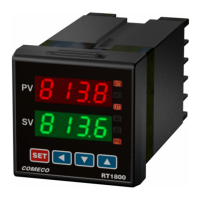17
4.2. Alarm type and function
CODE ALARM TYPE SUPPRESSION
00/10 No alarm
01 Deviation from set point - high limit YES
11 Deviation from set point - high limit NO
02 Deviation from set point - low limit YES
12 Deviation from set point - low limit NO
03
Deviation from set point – low and high limits
YES
13
Deviation from set point – low and high limits
NO
04/14 Deviation from set point INVERTED – low and high limits NO
05
Exceeding absolute value
YES
15
Exceeding absolute value
NO
06
Falling below absolute value
YES
16
Falling below absolute value
NO
07
End of period (only for profile control)
-
17
End of program (only for profile control)
-
08
System error – alarm goes ON
-
18
System error – alarm goes OFF
-
09
Enables RAMP-SOAK function
-
19
Timer alarm activated after predefined time
-
* "suppression" means that after power-on, alarm action is suppressed until the alarm situation normalizes
at least for a moment. In this way, alarm activation is avoided while the system is reaching steady state.
Detailed alarm function diagrams are given on the next page.
4.3. Error Messages
in1E
sensor open
AdCF
* DAC failure
CJCE
* input measurement circuit failure or
loose / missing cold junction temperature compensation sensor on controller back
in2E
additional input open
UUU1
measured value above high set-point limit (parameter USPL)
nnn1
measured value below low set-point limit (parameter LSPL)
UUU2
additional input signal above high range limit
nnn2
additional input signal below low range limit
rAMF
* RАМ failure
intF
interface problem
AUtF
unsuccessful auto-tuning
! When a message marked with " * " appears and stays, send the controller for repair.

